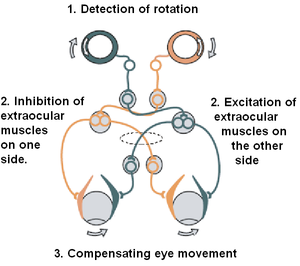
Back حملقة (فيزولوجيا) Arabic Vestibulookulärer Reflex German Reflejo vestíbulo-ocular Spanish رفلکس دهلیزی–چشمی Persian Réflexe vestibulo-oculaire French Riflesso vestibolo-oculare Italian 안뜰눈 반사 Korean Vestibulo-oculaire reflex Dutch Odruch przedsionkowo-oczny Polish Reflexo vestíbulo-ocular Portuguese

The vestibulo-ocular reflex (VOR) is a reflex that acts to stabilize gaze during head movement, with eye movement due to activation of the vestibular system, it is also known as the cervico-ocular reflex. The reflex acts to stabilize images on the retinas of the eye during head movement. Gaze is held steadily on a location by producing eye movements in the direction opposite that of head movement. For example, when the head moves to the right, the eyes move to the left, meaning the image a person sees stays the same even though the head has turned. Since slight head movement is present all the time, VOR is necessary for stabilizing vision: people with an impaired reflex find it difficult to read using print, because the eyes do not stabilise during small head tremors, and also because damage to reflex can cause nystagmus.[1]
The VOR does not depend on what is seen. It can also be activated by hot or cold stimulation of the inner ear, where the vestibular system sits, and works even in total darkness or when the eyes are closed. However, in the presence of light, the fixation reflex is also added to the movement.[2] Most features of VOR are present in kittens raised in complete darkness.[3]
In lower animals, the organs that coordinate balance and movement are not independent from eye movement. A fish, for instance, moves its eyes by reflex when its tail is moved. Humans have semicircular canals, neck muscle "stretch" receptors, and the utricle (gravity organ). Though the semicircular canals cause most of the reflexes which are responsive to acceleration, the maintaining of balance is mediated by the stretch of neck muscles and the pull of gravity on the utricle (otolith organ) of the inner ear.[2]
The VOR has both rotational and translational aspects. When the head rotates about any axis (horizontal, vertical, or torsional) distant visual images are stabilized by rotating the eyes about the same axis, but in the opposite direction.[4] When the head translates, for example during walking, the visual fixation point is maintained by rotating gaze direction in the opposite direction,[5] by an amount that depends on distance.[6]
- ^ "Vestibular nystagmus". www.dizziness-and-balance.com.
- ^ a b "Sensory Reception: Human Vision: Structure and function of the Human Eye" vol. 27, p. 179 Encyclopædia Britannica, 1987
- ^ Berthoz A, Jeannerod M, Vital-Durand F, Oliveras JL (1975-10-01). "Development of vestibulo-ocular responses in visually deprived kittens". Experimental Brain Research. 23 (4): 425–442. doi:10.1007/BF00238024. ISSN 1432-1106. PMID 1183513.
- ^ Crawford JD, Vilis T (March 1991). "Axes of eye rotation and Listing's law during rotations of the head". Journal of Neurophysiology. 65 (3): 407–23. doi:10.1152/jn.1991.65.3.407. PMID 2051188.
- ^ "VOR (Slow and Fast) | NOVEL – Daniel Gold Collection". collections.lib.utah.edu. Retrieved 2019-10-03.
- ^ Angelaki DE (July 2004). "Eyes on target: what neurons must do for the vestibuloocular reflex during linear motion". Journal of Neurophysiology. 92 (1): 20–35. doi:10.1152/jn.00047.2004. PMID 15212435. S2CID 15755814.